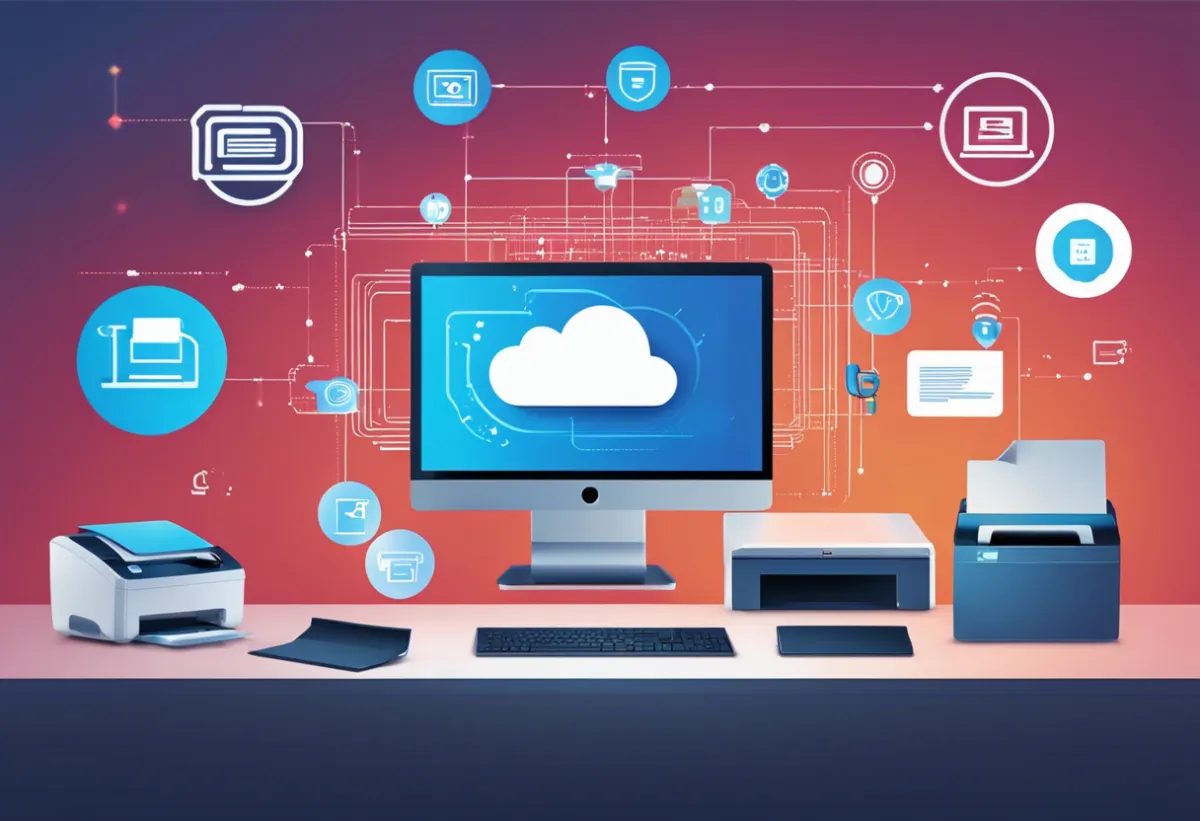The Future of Enhanced Printer Security: Leveraging Cloud-Based Monitoring

Introduction to Enhanced Printer Security
In today’s interconnected world, an increasing number of organizations are recognizing the critical importance of securing all networked devices, including printers. Modern printers, no longer merely standalone devices, are integral components of the networked digital ecosystem. They store, process, and transmit sensitive information, making them potential targets for cyberattacks. Enhanced printer security aims to address these vulnerabilities by adopting comprehensive security measures.
Key Drivers of Enhanced Printer Security
Several factors necessitate the prioritization of enhanced printer security:
- Confidential Data Protection: Printers often handle sensitive data such as financial reports, legal documents, and proprietary business information. Unauthorized access or data breaches can result in significant financial and reputational damage.
- Regulatory Compliance: Organizations must adhere to industry standards and regulations, such as GDPR, HIPAA, and Sarbanes-Oxley, which mandate stringent data protection measures. Non-compliance can lead to severe penalties.
- Remote Work Environment: With the rise in remote work, securing printers that are distributed across various locations and connected to different networks has become imperative to prevent cyber threats.
- Sophisticated Cyber Threats: As cyberattacks become more advanced, relying on basic security measures is no longer sufficient. Enhanced security protocols are essential to defend against evolving threats.
Core Components of Enhanced Printer Security
Effective printer security strategies encompass multiple layers:
- Authentication and Authorization: Implementing user authentication ensures that only authorized personnel can access the printer and its functions. Multi-factor authentication (MFA) adds an additional layer of security.
- Data Encryption: Encrypting data both at rest and in transit protects sensitive information from unauthorized interception or access. Secure Sockets Layer (SSL) or Transport Layer Security (TLS) protocols are commonly used.
- Firmware Integrity: Regularly updating printer firmware ensures that known vulnerabilities are patched. Firmware validation checks prevent the installation of malicious code.
- Device Monitoring: Continuous monitoring and logging of printer activities help detect and respond to suspicious actions in real-time, mitigating potential security breaches promptly.
The Role of User Education and Training
Ensuring that employees are educated about printer security best practices is a critical aspect of an effective security strategy. Training programs should include:
- Awareness of Potential Threats: Educating users about common printer-related threats, such as unauthorized access or data leakage, increases vigilance.
- Proper Usage Guidelines: Providing clear instructions on secure printing practices, such as using secure print release features and avoiding unmonitored print jobs.
- Incident Response Procedures: Establishing protocols for reporting and responding to suspected security incidents to minimize impact and facilitate quick resolution.
By integrating these elements, organizations can significantly bolster their printer security posture and safeguard their sensitive data against emerging cyber threats.
Current Challenges in Printer Security
Networked printers often serve as entry points for malicious activities due to their underestimated vulnerability. Addressing printer security encompasses several challenges:
- Lack of Awareness: Many organizations underestimate the importance of securing printers. This oversight can lead to undetected security breaches.
- Outdated Firmware: Older printer models often run on outdated firmware, which may have unpatched vulnerabilities. Regular updates are critical but frequently ignored.
- Weak Authentication Protocols: Printers generally rely on default or weak passwords. Implementing robust authentication measures is often neglected, compromising device security.
- Data Storage: Printers retain copies of printed documents in their memory. If not securely erased, these documents can be retrieved by unauthorized users, leading to data breaches.
- Network Exposure: Printers connected to the internet are exposed to potential attacks from external threats. Without proper firewall settings and security protocols, printers can be easily infiltrated.
- User Mistakes: Employees may unknowingly introduce security risks through actions such as connecting unsecured devices or using non-secure print methods.
- Lack of Encryption: Insufficient use of encryption for data in transit and at rest makes it easier for malicious actors to intercept sensitive information.
- Insufficient Monitoring: Without continuous monitoring, suspicious activities and potential security threats go unnoticed until significant damage has occurred.
Addressing these challenges necessitates a multifaceted approach incorporating robust policies, regular updates, and effective monitoring tools. Organizations must educate employees, improve endpoint security, and ensure consistent application of best security practices. Integrating cloud-based solutions for real-time monitoring and updates can significantly mitigate these risks.
The Evolution of Printer Security Technologies
Over the years, advancements in printer security technologies have mirrored the broader trends in cybersecurity. Printers, once considered simple peripheral devices, have become integral nodes in corporate networks. This evolution necessitated the development of robust security measures to protect both the devices and the sensitive data they handle.
Early Security Measures
- Password Protection: Initially, basic password protection was the primary defense against unauthorized access. It prevented casual users from manipulating printer settings or viewing confidential documents.
- Access Control Lists (ACLs): Organizations began implementing ACLs to specify which users or devices could send print jobs. This was a foundational step in segregating print jobs and restricting access.
Rise of Network-Based Threats
- Firewalls: As printers became network-enabled, they were susceptible to the same threats as computers. Firewalls were integrated to create a barrier between the printer and potential cyber threats.
- Encryption: The use of encryption for data transmission between devices and printers ensured that print jobs remained confidential and unaltered during transit.
Advanced Authentication Methods
- Multi-Factor Authentication (MFA): The inclusion of MFA became more prevalent, requiring users to provide multiple forms of verification before accessing printer functionalities.
- Biometric Access: Biometric systems, such as fingerprint scanners, provided another layer of protection, ensuring that only authorized personnel could use specific printer functions.
Modern Security Enhancements
- Intrusion Detection Systems (IDS): Modern printers now support IDS, which can detect and thwart suspicious activities in real-time.
- Secure Print Release: This technology holds print jobs in a queue until the user authenticates at the printer, ensuring that sensitive documents are not left unattended.
Cloud Integration and Future Prospects
- Cloud-Based Monitoring: Leveraging cloud-based monitoring solutions allows for real-time surveillance and analysis of printer activities. It helps in identifying anomalies and potential threats swiftly.
- Machine Learning and AI: By integrating machine learning and artificial intelligence, printers can adapt to emerging threats dynamically, offering proactive protection measures.
Adopting these evolving technologies is critical for organizations aiming to safeguard their data and ensure the integrity of their printing infrastructure.
Understanding Cloud-Based Monitoring
Cloud-based monitoring represents a transformative approach, utilizing cloud computing technology to oversee networked devices, including printers, in real-time. This method enhances security by offering several key functionalities:
- Real-Time Alerts:
- Immediate notifications for potential security breaches.
- Automated incident reporting for swift response.
- Centralized Management:
- Unified interface for monitoring multiple devices.
- Simplified policy enforcement across various locations.
- Scalability:
- Adaptive resource allocation based on usage.
- Support for extensive deployments without infrastructure overhaul.
- Data Analytics:
- Advanced analytics for identifying usage patterns.
- Predictive maintenance capabilities to prevent downtime.
- Compliance:
- Tools for ensuring adherence to regulatory standards.
- Audit trails for historical data verification.
Enhancing Security Through Continuous Monitoring
Continuous monitoring is paramount for securing printers from evolving threats. This proactive approach offers several advantages:
- Threat Detection:
- Early identification of vulnerabilities.
- Real-time anomaly tracking to counteract malicious activities.
- Firmware Integrity:
- Regular updates to patch security gaps.
- Verification processes to ensure software authenticity.
- Access Controls:
- User authentication protocols to restrict unauthorized access.
- Role-based access management to minimize risks.
Utilization of Automation in Cloud-Based Monitoring
Automation plays a significant role in augmenting the efficiency of cloud-based monitoring:
- Automated Patch Management:
- Deployment of updates with minimal human intervention.
- Scheduled scans and automatic application of critical fixes.
- Incident Response Automation:
- Predefined response actions for different threat levels.
- Machine learning algorithms to suggest optimal remediation steps.
- Workflow Automation:
- Streamlining administrative tasks related to audits and reporting.
- Integration with other security systems for coordinated defense mechanisms.
The adoption of cloud-based monitoring pioneers a shift towards more robust and reliable security frameworks for printer management. Such systems ensure that administrators can decisively mitigate risks while maintaining seamless operational workflows.
Benefits of Cloud-Based Monitoring for Printers
Cloud-based monitoring offers numerous advantages for organizations aiming to enhance the security and efficiency of their printing infrastructure.
Enhanced Security
- Real-time Threat Detection: Cloud-based solutions enable real-time monitoring, which assists in the immediate detection of suspicious activities.
- Automated Updates: Security patches and firmware updates are automatically deployed, ensuring that printers are always protected against the latest threats.
- Centralized Control: Central administrative control allows for the implementation of consistent security policies across all devices, minimizing vulnerabilities.
Operational Efficiency
- Remote Management: IT personnel can access and manage printer settings remotely, reducing the need for on-site visits and expediting issue resolution.
- Predictive Maintenance: Advanced analytics can predict potential hardware failures, enabling proactive maintenance and reducing downtime.
- Detailed Reporting: Comprehensive reporting capabilities provide insights into usage patterns, helping optimize resource allocation and reduce waste.
Cost Savings
- Reduced Downtime: By preventing major security breaches and hardware failures, organizations can avoid costly disruptions.
- Lower IT Overheads: Automated tasks and remote management tools decrease the workload on IT staff, allowing them to focus on more strategic initiatives.
- Scalability: Cloud solutions can easily scale with the growth of the organization, ensuring cost-effective adaptability without the need for substantial upfront investments.
Compliance and Data Protection
- Data Encryption: Cloud-based monitoring ensures that all data transmitted between printers and management systems are encrypted, safeguarding sensitive information.
- Audit Trails: Detailed logs of all activities can be maintained, aiding in compliance with industry regulations and standards.
- User Authentication: Multi-layered authentication mechanisms enhance access control, limiting the risk of unauthorized usage.
User Experience
- Simplified Interface: User-friendly dashboards provide an intuitive interface for monitoring and managing printer security.
- Custom Alerts: Notifications can be customized to alert specific personnel about different types of incidents, ensuring quick and appropriate responses.
- Mobile Access: Cloud-based systems often come with mobile applications, enabling on-the-go access and management of printing systems.
The implementation of cloud-based monitoring for printers signifies a major step forward in securing and optimizing printing operations, offering substantial benefits across various domains.Integration of Cloud Solutions in Existing Printer Infrastructure
Integrating cloud solutions into existing printer infrastructure involves several critical steps to ensure compatibility and enhance security. Proper implementation can streamline printer management, improve security, and reduce operational costs.
Assessment and Planning
- Assess Current Infrastructure: Evaluate existing printer hardware and software to determine compatibility with cloud solutions. Identify potential vulnerabilities and areas for improvement.
- Define Security Requirements: Establish security protocols and compliance standards. Ensure that cloud solutions meet organizational data protection requirements.
Selection of Cloud Solutions
- Compatibility: Choose cloud solutions that integrate seamlessly with existing printers. Solutions should support various models and configurations.
- Security Features: Opt for solutions offering advanced security features such as encryption, user authentication, and secure print release.
- Scalability: Ensure that the chosen cloud solutions can scale with organizational growth and adapt to future technological advancements.
Deployment and Configuration
- Install Cloud Software: Begin with pilot installations on select printers. Configure settings to match security policies and user requirements.
- Network Integration: Integrate the printer network with cloud services while maintaining network security. Use firewall and VPN technologies to secure communication channels.
- User Training: Conduct training sessions to ensure that staff understands new cloud functionalities and security practices.
Monitoring and Management
- Real-Time Monitoring: Implement continuous monitoring systems to track printer usage, detect anomalies, and respond to security incidents swiftly.
- Automated Updates: Enable automated updates for both cloud software and printer firmware to protect against emerging threats.
- Policy Enforcement: Utilize cloud-based management tools to implement and enforce usage policies, manage permissions, and ensure compliance.
Troubleshooting and Support
- Regular Audits: Schedule periodic security audits to identify weaknesses and ensure adherence to established protocols.
- Technical Support: Partner with cloud providers offering robust support services. Ensure availability of quick assistance for resolving integration issues and threats.
- User Feedback: Gather feedback from users to identify pain points and areas needing enhancement or additional training.
Integrating cloud solutions into existing printer infrastructures is vital for fostering a secure and efficient printing environment. Prioritizing compatibility, security, and user training ensures seamless adoption and maximizes the benefits of cloud-based monitoring and management.
Data Privacy and Security Concerns in Cloud Monitoring
Data privacy and security are paramount in cloud monitoring. Cloud-based monitoring systems for printers necessitate stringent measures to ensure that sensitive information transported and stored in the cloud remains protected.
Organizations face several challenges:
- Data Breaches: Unauthorized access can lead to data theft or loss. It is crucial to implement robust encryptions such as AES-256 to secure data both in transit and at rest.
- Compliance with Regulations: Different industries are governed by specific regulations, such as GDPR for the EU and HIPAA for healthcare in the U.S. Companies must ensure that their cloud services comply with these regulations to avoid legal repercussions.
- Access Control: Defining who has access to the monitoring data is critical. Employing multi-factor authentication (MFA) and role-based access control (RBAC) can mitigate the risks by restricting access to authorized personnel only.
- Data Sovereignty: Understanding where data is stored geographically is crucial as different countries have different laws regarding data privacy. Ensuring data sovereignty involves selecting data centers in regions with favorable data protection laws.
To tackle these issues, several best practices should be adopted:
- Regular Audits and Assessments: Regular security audits help identify vulnerabilities. Penetration testing and compliance assessments measure the effectiveness of security controls.
- Incident Response Plans: Having a detailed incident response plan ensures quick and efficient action during a security breach. This includes communication plans, data recovery protocols, and containment strategies.
- Employee Training: Human error is a significant risk factor. Regular training programs about data handling, recognizing phishing attempts, and proper use of cloud services can significantly mitigate risks.
- Vendor Transparency: Establishing clear communication with cloud vendors about their security measures, data handling practices, and SLA (Service Level Agreements) can provide additional assurance regarding data security.
Moreover, continuous monitoring and updating security protocols according to the latest threats and vulnerabilities ensure that the cloud monitoring systems stay resilient. With technological advancements, employing machine learning for threat detection can offer proactive identification and neutralization of potential security risks.
Case Studies: Successful Implementation of Cloud-Based Printer Security
Case Study 1: Global Financial Institution
A leading financial institution sought to enhance its printer security due to increasing incidents of unauthorized access. By integrating a cloud-based monitoring system, they achieved the following:
- Reduced Unauthorized Access: The institution saw an 80% reduction in unauthorized access through real-time threat detection and swift automated responses.
- Compliance Adherence: The cloud-based solution ensured compliance with financial regulations by maintaining audit logs and data encryption.
- Operational Efficiency: The centralized management console allowed IT staff to monitor and manage printers across global branches, reducing maintenance time by 50%.
Case Study 2: Healthcare Provider
A prominent healthcare provider aimed to protect sensitive patient information from potential breaches. By adopting cloud-enabled printer security, the organization realized significant outcomes:
- Enhanced Data Protection: Sensitive data was protected by end-to-end encryption, reducing the risk of data leakage.
- Access Control Management: The system enabled stringent access controls, ensuring only authorized personnel could print or retrieve documents.
- Incident Response: Integrated incident response mechanisms allowed for immediate action upon detecting suspicious activities, mitigating potential threats swiftly.
Case Study 3: Government Agency
A government agency required robust security measures for their extensive printer network to safeguard classified information. Implementation of a cloud-based monitoring solution offered:
- Scalable Security: The solution provided scalable security measures, effortlessly adapting to the agency’s expanding needs.
- Audit Readiness: Continuous monitoring and detailed logs facilitated swift preparation for audits and compliance checks.
- Cyber Threat Mitigation: Advanced threat detection capabilities identified and neutralized cyber threats before causing any damage.
Case Study 4: International Manufacturing Company
An international manufacturing company faced challenges in managing printer security across various locations. Cloud-based monitoring provided a comprehensive solution:
- Centralized Management: The company could oversee the security of all printers from a single platform, improving control and reducing IT overhead.
- Real-Time Alerts: Instant alerts for potential security breaches enabled timely intervention, preventing data breaches.
- Cost Savings: Reduced need for on-site hardware and minimized manual monitoring led to significant cost reductions.
These case studies illustrate the tangible benefits and enhanced security outcomes provided by cloud-based printer monitoring systems. Each organization, despite their varied requirements, found tailored solutions that met their security needs and improved operational efficiency.
Best Practices for Enhancing Printer Security with Cloud Monitoring
Enhancing printer security through cloud monitoring involves several critical practices designed to safeguard sensitive information and maintain operational integrity. Organizations must adopt comprehensive strategies to ensure that their printing environment remains secure against emerging threats. Here are some best practices for leveraging cloud technologies to fortify printer security:
1. Regularly Update Firmware and Software
- Automatic Updates: Enable automatic updates to ensure that printers receive the latest security patches.
- Vendor Support: Utilize manufacturer-recommended firmware and software updates to mitigate vulnerabilities promptly.
2. Implement Strong Authentication Methods
- Multi-Factor Authentication: Integrate multi-factor authentication (MFA) to enhance access control.
- Role-Based Access Control (RBAC): Assign permissions based on user roles to limit access to sensitive functions.
3. Encrypt Data Transmission
- End-to-End Encryption: Encrypt data from the moment it leaves the device until it reaches its destination.
- Secure Communication Channels: Use HTTPS and VPNs for secure data transfer over networks.
4. Conduct Regular Security Audits
- Compliance Checks: Regularly perform compliance audits to ensure adherence to security policies.
- Vulnerability Scanning: Utilize cloud tools to detect and resolve potential security weaknesses in real-time.
5. Monitor Printer Usage and Behavior
Implement robust monitoring solutions to detect anomalous behavior patterns.
- Logs and Alerts: Generate logs for all printing activities and set up real-time alerts for suspicious activities.
- User Behavior Analysis: Use AI-driven analytics to assess user behavior and detect potential insider threats.
6. Physical Security Measures
- Secure Location: Install printers in secure locations to prevent unauthorized physical access.
- Biometric Access: Incorporate biometric security measures for high-risk environments.
7. Educate Employees About Security Practices
- Training Programs: Conduct regular training sessions to keep employees informed about security policies and best practices.
- Awareness Campaigns: Launch security awareness campaigns to highlight the importance of protecting printer data.
8. Leverage Advanced Cloud Security Features
- Machine Learning: Utilize machine learning tools to predict and prevent cyber-attacks.
- Artificial Intelligence: Implement AI-driven solutions for enhanced threat detection and response.
By adhering to these best practices, organizations can significantly bolster their printer security posture, leveraging cloud-based monitoring to mitigate risks and ensure the integrity of their print environments.
Future Trends in Printer Security and Cloud Technology
Advancements in printer security and cloud technology signify a shift towards more robust and dynamic security mechanisms. Key trends include:
- Integration of AI and Machine Learning: AI and machine learning are expected to play a significant role by predicting potential threats and mitigating risks through continuous monitoring. The systems will learn from past incidents to improve their response to new and evolving threats.
- Zero Trust Security Models: The adoption of Zero Trust models ensures that printers are treated as critical endpoints. This approach mandates strict verification for every device or user attempting to access the network, thereby significantly minimizing security breaches.
- Advanced Encryption Techniques: Future printers will employ advanced encryption methods, encrypting data both in transit and at rest. This ensures that sensitive information remains secure during the entire printing process.
- Enhanced Authentication Protocols: Multi-factor authentication (MFA) and biometric verification will become standard to access printer settings and print jobs. This reduces unauthorized access and adds an additional layer of security.
- Real-time Threat Detection: Printers will be equipped with real-time threat detection systems to identify and respond to security threats instantaneously. These systems will alert administrators to potential breaches before they can escalate.
- Cloud-based Management: Cloud technology will enable centralized management and monitoring of printer networks. This allows for streamlined updates, real-time troubleshooting, and the implementation of security patches across multiple devices simultaneously.
- IoT Integration: As Internet of Things (IoT) devices proliferate, printer systems will become part of a larger, interconnected network. Security measures will evolve to cover potential vulnerabilities introduced by IoT integrations.
- Regulatory Compliance Automation: Automated tools will assist in ensuring that all security protocols comply with new regulations and standards. This reduces the burden on IT departments to manually update and audit compliance frequently.
By staying ahead of these trends, organizations can better protect their printing infrastructure from emerging threats.
Conclusion and Recommendations for Businesses
Transitioning to cloud-based monitoring for printer security entails several significant benefits that can be leveraged to safeguard business operations. By addressing the essential aspects of implementation and maintenance, businesses can ensure robust security and operational efficiency.
- Adopt a Multi-Layered Security Approach: Businesses should implement a combination of encryption, firewalls, and intrusion detection systems. Cloud-based monitoring provides seamless integration of these security measures.
- Regular Software Updates and Patching: Ensure printers and associated software are regularly updated. Cloud-based solutions often provide automated updates, reducing the risk of vulnerabilities.
- Employee Training and Awareness: Conduct regular training sessions to educate employees on secure printing practices. Emphasize the importance of user authentication and the risks of unsecured printing.
- Compliance with Industry Standards: Align printer security measures with relevant industry standards such as GDPR, HIPAA, or PCI-DSS. Cloud-based monitoring can help streamline compliance management.
- Utilize Advanced Analytics: Leverage advanced analytics provided by cloud-based monitoring solutions to identify irregular patterns and potential threats. This proactive approach helps in early detection and mitigation.
- Regular Audits and Assessments: Periodic security audits and assessments are crucial. Cloud-based monitoring tools can facilitate continuous monitoring and reporting, making audits more efficient and comprehensive.
“Implementing cloud-based monitoring solutions empowers businesses to shift from reactive to proactive security management.”
- Integration with Existing Security Systems: Ensure that cloud-based printer monitoring systems are compatible with other security systems in place. This cohesive integration enhances the overall security posture.
- Cost-Benefit Analysis: Conduct a thorough cost-benefit analysis to justify the initial investment in cloud-based monitoring. Highlight long-term savings and risk mitigation benefits.
- Scalability Considerations: Choose scalable cloud solutions that can grow with the business. This flexibility is vital for accommodating expanding operations without compromising security.
- Vendor Selection: Carefully select vendors with a proven track record in cloud-based security solutions. Evaluate their reputation, reviews, and support services.
By incorporating these recommendations, businesses can effectively leverage cloud-based printer monitoring to enhance security, ensure compliance, and maintain operational integrity.




